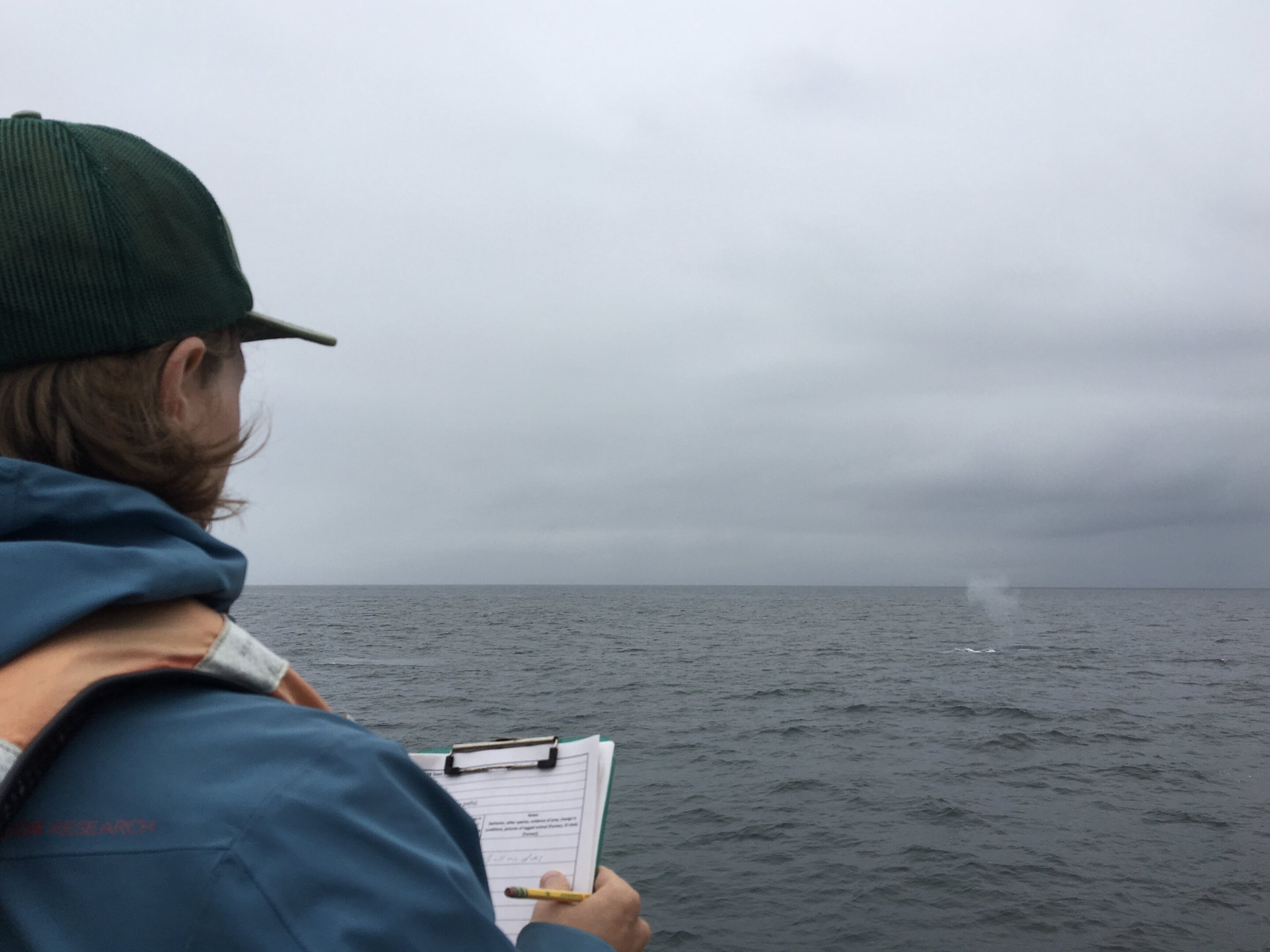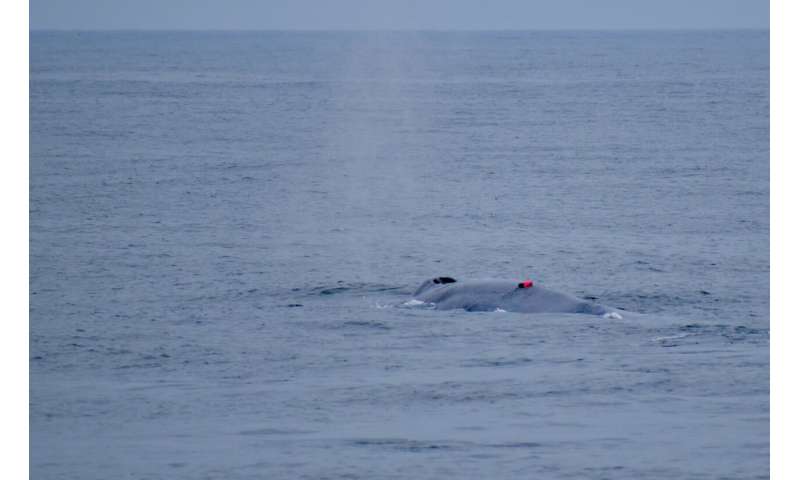#Pattern in whale songs predicts migration

“#Pattern in whale songs predicts migration”

Through the use of two advanced audio recording technologies, a collaboration of Monterey Bay researchers has found that blue whales switch from nighttime to daytime singing when they are starting to migrate.
The blue whale is the largest animal on Earth. It’s also among the loudest.
“Sound is a vital mode of communication in the ocean environment, especially over long distances,” said William Oestreich, a graduate student in biology at Stanford University’s Hopkins Marine Station. “Light, or any sort of visual cue, is often not as effective in the ocean as it is on land. So many marine organisms use sound for a variety of purposes, including communicating and targeting food through echolocation.”
Although whale songs have been studied for decades, researchers have had limited success in deciphering their meaning. Now, by recording both individual whales and their greater populations in the Northeast Pacific, researchers from Stanford and the Monterey Bay Aquarium Research Institute (MBARI) have identified patterns in the trills and bellows of blue whales that indicate when the animals are migrating from their feeding grounds off the North American coast to their breeding grounds off Central America. Their research was published Oct. 1 in Current Biology.
“We decided to compare daytime and nighttime song patterns from month to month, and there, in the divergence and convergence of two lines, was this beautiful signal that neither of us really expected,” said John Ryan, a biological oceanographer at MBARI and senior author of the paper. “As soon as that image popped up on the screen, Will and I were both like, ‘Hello, behavior.'”
Further analysis across the five years of hydrophone recordings could reveal new information about blue whale migration, a 4,000-mile journey that ranks among the longest in the world—and which the creatures repeat every year. Despite the immensity of blue whales and their travels, scientists know very little about their behaviors, such as how they are responding to changes in the ecosystem and food supply from year to year. Being able to predict the travel of whales along this important route could also help prevent ship strikes.
Supping and singing
To capture whales singing solo and in chorus, the researchers used two advanced recording technologies: an underwater microphone—or hydrophone—and tags that the researchers placed on individual whales.
In 2015, MBARI deposited a hydrophone 18 miles off the Monterey coast, 3,000 feet (900 meters) under sea level. The hydrophone is wired to their MARS undersea cabled observatory, which provides it with power and communications. This seafloor eavesdropper has recorded the deep ocean soundscape almost continuously for more than five years.
“The hydrophone fits in your hand,” said Ryan, who recommends listening to the hydrophone livestream in fall for optimal whale music (although only the humpback whale song can be heard through ordinary speakers). “It’s a little instrument that produces big data—about two terabytes per month.”
By focusing on the whale song wavelengths in the hydrophone data, the researchers noticed a distinct change over several months. Through the summers, the whale arias grew louder and were sung mostly at nighttime. Over the five years of data, the whale chorus was loudest around October and November, and singing happened more at nighttime. Following each annual peak in song activity, as the whales began to depart for warmer waters, singing became more of a daytime activity.

While daytime versus nighttime differences in singing behavior had been noted in previous research, the whale-borne tags, developed by the lab of Stanford biologist Jeremy Goldbogen, helped explain what these 24-hour patterns and their inversion in late autumn could mean. Fifteen tags tracked the sounds of their carriers through accelerometer measurements—which monitor vibrations—and, in some cases, integrated hydrophones. In the summer, the whales spent much of the daytime feasting, bulking up for the long journey ahead and reserved their musical interludes for nighttime. When the time came, migration was again accompanied by daytime songs.
“In the hydrophone data, we saw really strong patterns over this enormous spatial domain. When we saw the exact same pattern on individual animals, we realized that what we’d been measuring over hundreds of kilometers is actually a real behavioral signal—and one that represents the behavior of many different whales,” said Oestreich. “As an ecologist, it’s very exciting to observe so many whales, simultaneously, using one instrument.”
Listening and learning
This research lays the groundwork for possibly predicting blue whale migration based on the transitions between the different song schedules—such forecasts could be used to warn shipping lanes further down the coast, like air traffic control but for the ocean. The researchers also hope that further analysis of the acoustic data will reveal more about whale behavior in response to environmental changes, such as warming waters and fickle food supplies.
“If, for example, we can detect differences in migration and foraging in response to changes in the environment, that is a really powerful and important way to keep an eye on this critically endangered species,” said Goldbogen, who is an assistant professor of biology in the School of Humanities and Sciences and also senior author of the paper. “That’s economically important, ecologically important and also culturally important.”
Already, Oestreich is pursuing a related question: If we can use this signal to determine whether whales are foraging or migrating, are whales using it that way too? It’s possible, said Oestreich, that a lone whale might listen around before giving up on feeding and heading south.
“Blue whales exist at incredibly low densities with enormous distances between them but, clearly, are sharing information in some way,” said Oestreich. “Trying to understand that information sharing is one motivation, but also potentially using that signaling as a means to study them is another exciting possibility.”
Australians hope to save whale from crocodile-infested river
Current Biology, Oestreich et al.: “Animal-borne metrics enable acoustic detection of blue whale migration” www.cell.com/current-biology/f … 0960-9822(20)31331-2 , DOI: 10.1016/j.cub.2020.08.105
Citation:
Pattern in whale songs predicts migration (2020, October 1)
retrieved 1 October 2020
from https://phys.org/news/2020-10-pattern-whale-songs-migration.html
This document is subject to copyright. Apart from any fair dealing for the purpose of private study or research, no
part may be reproduced without the written permission. The content is provided for information purposes only.
For forums sites go to Forum.BuradaBiliyorum.Com
If you want to read more Like this articles, you can visit our Science category.


